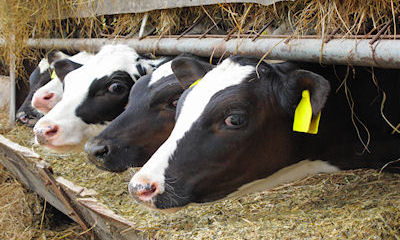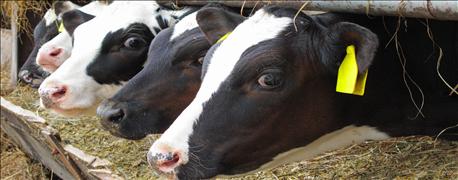May 24, 2016

With the wet spring we have had, increased numbers of flies are expected. While 100% elimination of flies is not possible, it is possible to control and reduce fly numbers. The two principle fly pests are house flies and stable flies.
House flies are nonbiting insects that breed in animal droppings, manure piles, decaying silage, spilled feed, bedding, and other organic matter. While house flies are only a minor annoyance to animals, they have considerable potential to transmit disease and parasites. The female housefly lives 10 – 21 days and can produce 150 to 200 eggs per batch. Batches of eggs are laid in three to four day intervals.

Control flies on dairy cattle
Stable flies are about the same size as house flies, except the adult has a piercing mouthpart that protrudes from under its head. The stable fly breeds in wet straw and manure, spilled feeds, silage, grass clippings, and various other types of decaying vegetation. Female stable flies live 20-30 days and lay 200 to 400 eggs.
Cattle are most irritated by these pests during the warm summer months. Both male and female stable flies feed on blood several times each day. Production performance declines in infested herds because of the painful bites the cows sustain and the animals’ fatigue from efforts to dislodge the flies.
Demographic changes that have brought neighborhoods closer to farms have increased the pressure to control these flies. There are three main types of fly control options: Physical, biological, and chemical.
Physical control of flies is accomplished by removing the material used for fly breeding and egg deposition at least once a week. The life cycle of the fly requires immature flies to live in this material for 10 to 21 days, if the material is removed and spread, the life cycle of the fly can be broken. Therefore, weekly removal and spreading of manure and wet feed is encouraged to keep fly numbers low.
Biological fly control uses natural enemies of flies to reduce fly populations. Many bird species including bluebirds, purple martins, and tree or barn swallows feed on flies. To attract purple martins to your property you can hang groups of gourds on your property for housing. Bluebirds prefer wooded areas, so if your farm is near a pasture and wooded areas, hang bluebird nesting boxes 100 yards apart at the edge of the fields.
Parasitic wasp larvae are another biological control method. Larvae can be purchased from biological supply houses. The adults do not sting cattle or humans. Parasitic wasps occur naturally in areas that have flies; however their numbers normally lag behind the flies. Parasitic wasps are more susceptible to insecticides, so sprays that kill flies kill larger numbers of parasitic wasps. Beetles and mites are also natural enemies to the fly and will eat fly eggs and larvae.
Chemical control methods exist for different life stages of the fly. For maximum effectiveness you should use chemicals that kill both the larvae and the adult flies.
It is important to verify with your veterinarian that any product used is approved for lactating dairy cattle. Popular fly control methods for cattle include: chemical – impregnated ear tags, fly blocks, foggers, exit lane dusters, and pasture back rubs.
Effective control of flies requires a combination of control mechanisms. Minimizing chemical controls will allow natural biological controls to combat flies without increasing fly resistance to chemicals.
Schlesser is the Marathon County Extension dairy and livestock agent.
You May Also Like




